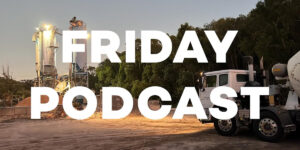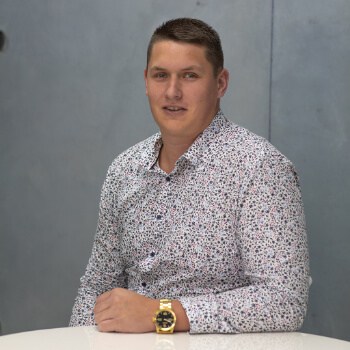Laike and Doug wrap up their week again with a 10-minute chat. They’ve each been travelling, and Doug discusses a particular challenge for concrete in Western Australia. Then they focus on a new topic – low carbon concrete.
Doug & Laike Share Their Week – Western Australia, Christchurch, and a Focus on Low Carbon Concrete

Invisible Strength
Doug & Laike Share Their Week – Western Australia, Christchurch, and a Focus on Low Carbon Concrete
/
RSS Feed
Doug & Laike Share Their Week – Western Australia, Christchurch, and a Focus on Low Carbon Concrete
Curing in the heat: https://markhamglobal.com/news/summer-curing/
Wagner Earth Friendly Concrete: https://earthfriendlyconcrete.com/about/
View the Transcript
LAIKE: G’day guys, we’re back here, me and Doug for another weekly Friday podcast. It’s Friday afternoon here last week of the month. How’s your week been?
DOUG: Yes, good, man. Yes. We went across to WA for Monday to Wednesday. Yes. Just a quick trip this time. No, it’s good to see everyone over there. Everyone’s keeping busy. Pipelines are looking full. A little bit of uncertainty around the…with the elections coming up and that sort of thing, as there always is in an election year, but there’s plenty in the pipeline, it’s good to see.
We chat about the, you know, challenges that they get, specific in WA, you know, the hot weather, that type of thing. It causes a few issues when you’re trying to pour concrete. And there is a lot of concrete getting poured and they can’t stop just because of hot weather, you know? So they do what they can to manage it. But then we can supply things like curing and admixtures to make their life easier, especially where it’s a high-durability mix. But anyway. What about you? How’s your week going?
LAIKE: Yes. No, been a good week, I was down in Christchurch on the Wednesday, meeting a couple of clients regarding a few projects that are coming up in the pipeline and then also just, you know, relationship building, you know, just popping in to say ‘Hello’; seeing how things are tracking. It gives you a good idea of where the market’s heading and what people are experiencing out there.
DOUG: Yes, yes. That’s awesome. So yes, we wanted to do something, start sort of looking at a topic with these podcasts. So looking at first one, we wanted to kind of address, which will probably take, I don’t know, there’s a lot of lot on the topic, a lot of sub categories. That’s low carbon concrete. So it’s a fairly hot topic. It’s talked about a lot out in the industry. There’s, you know, they’re setting certain targets that have been set by the concrete industry to try and, you know, lower the carbon emissions.
Obviously concrete sitting at around 8%, I think, of the world’s CO2 emissions. So it is a significant contributor. It is also a long-lasting material too. So you’ve got to kind of weigh out those two things. But specifically looking at low carbon concrete. I guess what…what do you know about it? You’ve been here a couple of years. What’s your, sort of, take on it?
LAIKE: Yes, definitely starting to see a lot more of it coming up. Are you like it’s, you know, the whole carbon idea being a big topic out there on the news for the last couple of years and it’s definitely finding different ways, especially in construction about how to, you know, reducing that carbon footprint. Which, you know, carbon concrete as such can contribute to.
DOUG: Yes, yes, 100%. And I think overall seeing a shift in focus like it used to be almost a nice-to-have to have a low carbon concrete. Now we’ve… As an industry, we’ve kind of got a lot further down that track, I feel, and there’s options out there that are cost competitive. You know, they are actually getting put into projects and not just being talked about as a nice-to-have, so to speak. So yes, it is really good to see.
As far as what they actually are – we want to just touch on that today. So there’s a few different ways. Obviously the main goal is to lower that carbon emission level, and it’s particularly to do with the cement production, that’s the real… well, the majority of that, that carbon content, so to speak. Should we have a quick Google anyway? Yes. See what that says. I’ll share my screen. So yes, the typical sort of Google answer to that, or the AI summary. We’ll just pick on how it’s produced. So combining industrial cement with mineral compounds such as calcine clays, fly ash, blast furnace slag.
So yes, that’s really what we want to talk about today, is, you know, what that’s made up of. And a lot of what we’re seeing is around the the use of slag and fly ash in the concrete, so GGBFS or ground granulated blast furnace slag, for its full title. And that comes out of the steel industry. So it’s a byproduct of the of the steel making process. It does tend to be a lot more consistent than, say, something like a fly ash, that can vary between suppliers, that type of thing, there’s different classes.
But in general slag is more friendly and it’s more sort of universal, easier to put into the concrete mixes. So that is a lot of what we’re seeing in the market in Australia and New Zealand as a… somewhere… Well, it’s not even a common percentage replacement really, but that’s anywhere from 20% right up to 65% depending on what the mix is wanting to do. So that’s, you know, that’s what we’re seeing that going into projects today. So it’s not something that’s in a trial phase.
LAIKE: And definitely a lot more with the sustainable side as well. The Green star ratings etc, that everyone … or we’re starting to see a lot more of in the industry at the moment, which, you know, [low] carbon concrete can help with that Green Star rating due to it being made out of it more sustainable materials and overall a bit more sustainable than general kind of concrete.
DOUG: Yes, yes. No, that’s good. So I think that’s probably enough on that particular question. So yes, what we’re seeing, they’re made up. of the ground blast furnace slag or they’re made from some high fly ash replacements with slag. You get a lot quicker strength gain than you do with fly ash. So that’s another advantage there.
And then there is other work going on, it’s probably more in development stage. There are some that have been taken to market where they’re using a completely different type of cement. So there’s the Wagner Earth Friendly Concrete that uses a completely different cement type. It’s obviously come… has a lower carbon footprint with it. So there’s things like that and then, you know, the geopolymer concretes and people challenging the whole, you know, do we even need your standard cement? I mean, can we make a, you know, a harder material out of other chemicals and things? So yes, there’s plenty going on in that space. But as far as something that is sort of market-ready, we’re seeing being implemented out there that can reduce that carbon, it does come back to that blast furnace slag. What we’re seeing there.
LAIKE: It’s also reduces a lot of the need for, you know, reo and metalwork inside the concrete as well, just due to those carbon fibres in the concrete. It can be… I was reading something on the Google page earlier before about the rust as well. There’s just so many different things that can contribute to kind of that carbon footprint.
DOUG: I think that’s I think that’s more… what are you looking at there? Is it more about putting carbon fibre into the concrete? So yes, that’s slightly different to the low carbon concrete. So low carbon is talking about the emissions of the cement. This is talking about using carbon as a fibre in the concrete; or sometimes they put things like… I think it’s graphene or something, into the concrete for strength. But yes that’s good. I don’t have a whole lot more to say on that topic.
LAIKE: No, I think we’ve covered it pretty basically. It was good, short and sharp.
DOUG: Yes. We’ve got a bit of a list we’re going to be working through. Some of the key industry questions and discussions. It’s obviously an open discussion. If there’s anything we’ve said here that needs correcting or improving, or you’ve got any further questions on the topic, please put them in the comments below, and we’ll talk about them. And yes, if you want to come on and share your experience with low carbon concrete, we’re more than happy to join you on the call or give you a call and talk about it. Yes. So what’s up this weekend, Laike?
LAIKE: Heading to the Bay of Plenty, got a bit of a rugby game happening up there with a few lads, so that should be good laugh. Yourself?
DOUG: Nice! You playing prop, or no?
LAIKE: No no, not a prop!
DOUG: No, nothing, really. Just hanging out with a few friends. And yes, the general weekend stuff.
LAIKE: Yes. Good. Alrighty. Thanks all.
DOUG: Mā te wā!
LAIKE: We’ll catch up again next Friday. Cheers!
Want to Contribute?
Feedback on our podcasts? Suggestions for future topics? Looking for more information on topics we’ve discussed? Send us a message – we’ll be in touch within a day or two.
More about MARKHAM
MARKHAM are dedicated to providing innovations for concrete and construction. Focusing on concrete waterproofing solutions, penetrating concrete sealers and durability treatments for concrete.
Podcast Categories
Latest Episodes

Doug & Laike Share Their Week – Western Australia, Christchurch, and a Focus on Low Carbon Concrete
Laike and Doug wrap up their week again with a 10-minute chat. They’ve each been

Doug & Henry Share Their Week – R&D, Melbourne Traffic, Basement Waterproofing, And ‘CONQOR Your Health’
It’s Henry’s turn to join Doug in the podcast studio – in person this time!

Doug & Laike Share Their Week – Seychelles, Readymix Plants, And A Bike Ride
Once again Doug and Laike sit down for a 10 minute recap from the week.
invisible strength podcast
The whole MARKHAM team is pleased to present you with our podcast series, INVISIBLE STRENGTH. In this series of interviews, we’ll walk through the science and challenges of concrete durability, what goes wrong in the field – and the advanced methods available to restore and enhance service life to concrete construction.
INVISIBLE STRENGTH reflects a number of factors in concrete construction and durability. When things go wrong, the evidence can become very visible indeed. However, when all is going well, there’s nothing particular to be seen!
MARKHAM’s concrete treatments, too, are invisible once completed – and the result is the long internal, invisible durability of the concrete.
So join us as we explore the unseen world inside concrete – why it matters, and how it can be protected!

